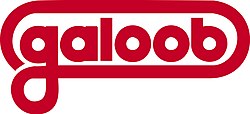Galoob
| Lewis Galoob Toys, Inc.
|
|
|---|---|
| legal form | Inc. |
| founding | 1957 |
| resolution | 1998 |
| Reason for dissolution | Purchased through Hasbro |
| Seat | San Francisco , United States |
| Branch | Toy maker |
Galoob , was an American toy manufacturer based in San Francisco . The company was best known for its Micro-Machines toy cars. After several failures, the company ran into financial difficulties and was bought by Hasbro in 1998 .
history
Galoob was founded in 1957 by Barbara and Lewis Galoob. At first the company was still a distributor for office supplies and toys. The introduction of the Jolly Chimp , a battery-powered toy monkey, was the company's first major success. For health reasons, Lewis Galoob handed over management of the company to his sons David and Robert in 1970.
David and Robert Galoob continued to run the company successfully, increasing sales to over $ 1 million by 1976 . In 1976 they laid another foundation stone for the company's success with the purchase of a manufacturer of radio-controlled cars. With the sale of radio-controlled trucks and cars, sales rose to $ 5 million by 1978. From the 1970s, Galoob began selling licensed and merchandising products. The licensed characters of the Smurfs and the Mister T figure were particularly successful , with which the company's sales rose to over $ 28 million by 1983. With a special remote-controlled off-road car called The Animal , which was supposed to drive particularly well off-road with the help of extendable claws, a turnover of 100 million dollars was finally achieved by 1985.
In the next few years Galoob could no longer build on previous successes. In addition to a number of unsuccessful products on the market such as the strobe dice , an electronic dice game or baby talk , a talking doll, the increasing popularity of electronic toys and the more favorable production conditions in China contributed to this. In 1987, Galoob suffered a loss of $ 25 million.
In 1987 Galoob landed a coup with the introduction of the Micro Machines . The products sold well and soon made up a large part of sales. In 1989, Micro Machines accounted for a good 60% of the $ 228 million turnover.
In the early 1990s, business was again bad for the company. In addition to a sharp drop in sales, Galoob was found guilty of misleading advertising by the Federal Trade Commission . Galoob had to lay off workers and also parted ways with David Galoob. Under the new managing director Mark Goldmann, the company concentrated on the successful core business with micro machines and expanded their product range to include numerous licensed products such as Star Wars , Star Trek and Power Rangers . This increased sales from $ 43 million in 1991 to $ 113 million in 1994.
With new products such as the Sky Dancer, an airworthy fairy figure, dollhouses and video game accessories, Galoob was able to establish itself as the third largest American toy manufacturer by 1995 with a turnover of 220 million dollars. The Sky Dancer in particular was a huge success and became one of the best-selling girls' toys ever. After losing again in the following years, the toy manufacturer Hasbro Galoob took over in 1998 for a purchase price of $ 220 million.
Game genius

In 1992 Galoob released the Game Genie Cartridge for various video game consoles from Nintendo and Sega . This allowed the use of so-called cheats in various games , which gave the player additional lives, weapons or other features that were not intended in the games. The rights to the module had been acquired from Codemasters . In 1992, Galoob earned $ 65 million with the Game Genie, but by 1994 sales had dropped to less than 7% as they couldn't keep up with developments in the console and video game market.
Nintendo's lawsuit against Galoob
In contrast to Sega, who supported the Game Genie module, Nintendo did not like it that their games were modified with the module. Nintendo obtained an injunction against the sale in the US and sued Galoob for copyright infringement. However, the court came to the conclusion that the use of the module did not infringe Nintendo's copyright and dismissed the lawsuit. Nintendo was also sentenced to pay Galoob loss compensation for the duration of the $ 16 million sale suspended by injunction.
Web links
Individual evidence
- ↑ a b c d e f g h i j k l Rodney P. Carlisle: Encyclopedia of Play in Today's Society, Volume 1, SAGE, 2009, p. 249
- ↑ a b c History of Lewis Galoob Toys Inc. on FundingUniverse (accessed April 8, 2016)
- ↑ The Animal by Galoob , commercial on YouTube , (accessed April 8, 2016)
- ↑ FTC Commission Decisions, Volume 114, January - December 1991, pp. 187–229 ( PDF , 5.5MB)
- ↑ a b c d e f g Rodney P. Carlisle: Encyclopedia of Play in Today's Society, Volume 1, SAGE, 2009, p. 250
- ↑ Sky Dancers Commercial - Commercial on YouTube, (accessed April 9, 2016)
- ^ Lewis Galoob Toys, Inc. v. Nintendo of America, Inc., 780 F. Supp. 1283 - Dist. Court, ND California 1991 - ( Google Scholar ) (accessed April 9, 2016)
